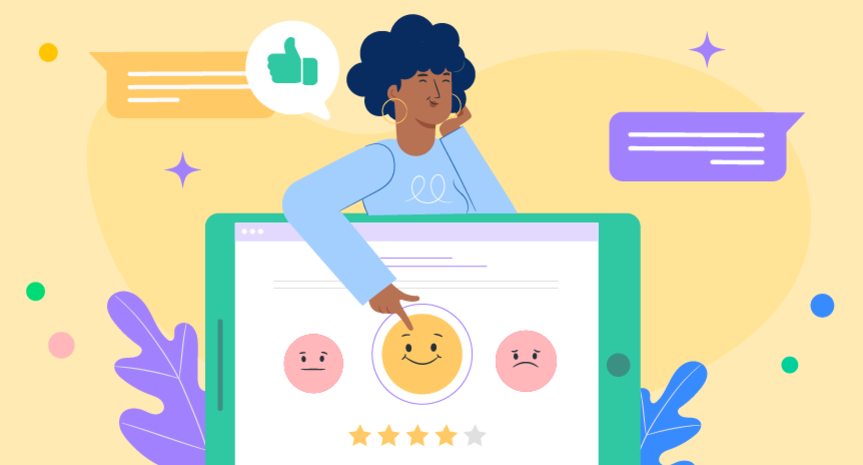How clearly can you picture the person you want to provide coaching services to? What does your potential client look like? What are their pain points? You may believe you already know your potential clients well. However, a married male aged 30 to 45 who is a small business owner is not enough.
Your clients are your most valuable asset. By understanding your clients’ needs and being able to meet those needs, you’ll be able to gain a strong competitive edge. To attract new and retain existing clients — and to make the right business decisions — you should always keep the image of your ideal coaching clients in mind. That’s why you need to create an ideal client profile, or ICP.
In this article, you’ll learn what an ideal client profile is, why you need one, how to create one, and what mistakes to avoid when developing it. Read on.
What is an ideal client profile?
What exactly is an ideal client profile? It describes a fictional person who combines a set of qualities and characteristics inherent in a segment of your target audience. Put differently, it’s an image of your average buyer. It’s critical that this image is as real as possible. The better your ideal client profile, the more targeted the messages you’ll be able to create.
People often confuse the concepts of target audience and customer profile. Let’s make sure you understand the differences between them.
A client profile, or a client portrait, is an image of a real client for whom your services solve a problem. A client profile differs from the description of your target audience in that it’s a detailed description of a single user who represents a specific audience segment.
Put simply, your target audience is a group of people your services are aimed at, while a client profile is a generalized image of a (hypothetical) typical representative of your target audience. A target audience is broader than a client profile.

Why create an ideal client profile?
Knowing your customer means knowing what your customer really wants.
There are a number of reasons why creating an ideal client profile is crucial. A well-established ICP allows you to:
- Understand your clients, i.e. understand their needs, wants, goals, and challenges
- Create your USP (unique selling proposition) to frame the benefits of your services to match your clients’ needs
- Identify marketing channels to promote your services effectively and avoid wasting your time and money
- Create targeted content that will solve your clients’ specific problems
- Build an accurate advertising campaign to reach the right people with the right message in the right places
- Bring in more clients to earn more revenue
How to create your ideal coaching client profile in 5 steps
To create your ideal coaching client profile, follow these five simple steps.
Step 1. Gather client data
Gather all the information you have about your existing clients to identify who is getting the most value from your coaching services. In other words, while building an ideal client profile, coaching topics have to be deeply investigated in order to see how much your services contribute to your clients’ overall success. Pool as much information as possible.
There are several sources from which to gather client data:
- Your customer relationship management (CRM) system
- Client interviews
- Social media
- Client surveys
Your CRM system
It’s perfect if you have a CRM system containing data about each of your clients. A CRM enables you to analyze your clients’ needs as well as anticipate their problems at the right time. This helps you increase customer satisfaction and ensure customer loyalty as well as generate a higher profit.
Client interviews
Another effective way to gather data is to conduct in-depth interviews with your clients. Nobody will give you more accurate and more complete information about your clients than the clients themselves. Some questions to ask are:
- How much research do you conduct and where do you do that research before making a purchase?
- Do you rely on referrals to find the services you need?
- How did you find me?
- Are you a decision-maker, or do you require your team’s/company’s approval?
- What led you to pay for my services?
- Why do you continue using my services?
- What attracts your attention and disposes you to make a purchase?
- What fears and concerns do you have when choosing a coaching service?
Avoid general questions so you don’t get general answers. Also, ask follow-up questions to clarify and elicit details. You don’t need to conduct 100 interviews. Seven to fifteen are enough to create a portrait of your ideal client. If your client base is small and you have nobody to interview, think about the types of potential clients who would most benefit from your coaching services and put down imagined answers.
Social media
You can analyze the profiles of your competitors’ followers on social media to gather information. A client’s social media profile can tell you about the client’s:
- Place of work
- Marital status
- Check-ins
- Events they are interested in and attend
- Music and movie preferences
- Favorite books, sports, and TV shows
- Pages they like
- Etc.
Pay attention to groups and communities your target prospects are members of. This will also help you understand what topics they’re interested in.
Client surveys
Another way to gather client data is by running an online survey. You can use various channels to distribute your coaching client surveys:
- Online survey development tools like SurveyMonkey and Typeform
- Your website
- Social media
Step 2. Review your client journey map
Creating a client journey map requires effort and provides an in-depth view of your clients and their interactions with your brand. Yet, it is not necessary to create a map to understand your target audience; simply considering an ideal coaching client’s journey might be enough.
Gaining an insight into your clients’ needs, challenges, and goals will give you a better idea of what they expect from your business. You can strengthen your understanding by interviewing your clients to gain a comprehensive view of each step of your journey.
Step 3. Describe your coaching clients
Now it’s time to describe your clients based on the information you’ve gathered.
To define an ideal client for your coaching business, think about both demographics and psychographics.
Demographics
Demographics is the most common way to build your ideal client profile, coaching specialists often include such details as:
- Gender
- Location
- Age
- Ethnicity
- Education
- Marital status
- Parental status
- Industry
- Occupation
- Company size
- Income
As we’ve already mentioned, you can gather this data from your CRM, directly from your clients, or from social media. To learn what income your target prospects earn on average, you can use resources like salary.com and paylab.com.
Psychographics
With psychographics, you want to get inside the head of your coaching client. Looking at the psychographic traits of your clients means focusing on personality traits, aspirations, attitudes, values, goals, pain points, interests, beliefs, concerns, fears, risks, challenges, objections, decision-making factors, etc.
While psychographics can be harder to measure, they are often crucial to understanding what drives people to pay for your coaching services. Understanding your clients’ psychographic traits will help you communicate your message and build rapport.
7 questions to ask
Here is an ideal client profile coaching checklist with the key questions you can ask yourself in order to deeply understand the psychographics of your ideal client.
- What are your clients’ goals? In other words, what change are clients seeking and what do they want to be different in their lives?
- What are your clients’ top values? Values are the basis of motivation.
- What are the negative impacts of the problems they face? Anytime we have something in our life that we’re not happy with or that we’re struggling with, it has an impact on all areas of our life. Find out how the transformation your clients want to achieve is impacting their lives.
- What fears are keeping them stuck? What challenges are preventing your clients from being able to truly make progress to achieve the desired change?
- What have they already tried? Did it work? What strategies, tools, or methods have your clients tried to reach their goals?
- What is going to happen in their lives if they don’t achieve this change now? What is going to happen three, five, or ten years from now if your clients don’t actually make this change?
- Where do they hang out on social media? What are your clients’ preferred social media channels for information, entertainment, reviews, etc?
Give as many answers to these questions as possible to develop a list of your ideal coaching client’s characteristics. These questions and answers will enable you to further laser target your ideal client. Feel free to add any questions that may help you get a deeper understanding of your client.
To understand how your services can help your clients solve their problems and achieve the transformation they want, describe their current state (how they feel, what pain points they have, what their average day looks like) and their desired state (what they want their personal and/or professional life to look like, what they want to feel and have).

Step 4 . Focus on what your brand is trying to solve
If you find yourself overwhelmed by lots of data you have, focus on the problem your business is trying to solve. Analyze your current clients and their behaviors to identify those facing this challenge. Whether you have a few clients or a rapidly growing client base, the key to success lies in understanding who your clients are.
Step 5. Fill in your ICP
Once you’ve gathered all necessary information, narrowed down your top clients, and listed all their demographic and psychographic characteristics, organize your findings and compile your ICP.
Depending on your niche and your potential clients’ peculiarities, you may add or remove any of these parameters. You can download and use an ideal client profile template below and make any changes necessary. Just print out the file or edit it in an online PDF editor.

Practical applications of ideal client profiles
While establishing an ideal client profile, coaching specialists can forge marketing strategies, ensuring they allocate time and resources to those potential clients who are likely to provide the most value to your coaching business.
Here are some basic practical ways to use your ICP for marketing:
- Segment your target audience and engage in personalization
With a solid ideal client profile, you’ll be able to identify target audience segments with the greatest potential, understand the needs and expectations of your prospects, and reach them via their preferred communication channels.
- Formulate your value proposition
When you clearly understand your target prospects’ pains, problems, goals, and challenges, you can shape your value proposition and explain to your potential clients how your services can help them achieve their desired transformation and what value they will get as a result while overcoming their fears and objections.
- Define your positioning
Your positioning allows you to stand out from your competition, win your audience’s loyalty, and increase audience retention. A carefully thought out client profile will help you take your place in the market and gain a sustainable competitive advantage.
- Set the right prices
The price you set for your services should reflect your clients’ perceived value. You can determine the price for your services that is most likely to benefit both your clients and your business through establishing a solid ideal client profile. It will help you understand how much your clients are ready to pay.
- Target ads
Knowing where your prospects hang out, on what channels and in what formats they prefer to interact with advertising, and what languages they speak will enable you to target your ads to the right people in the right places. Using spray-and-pray advertising and trying to offer your services to each and every person will be a waste of your time and financial resources.
- Craft consistent messaging
When you know your prospects’ pain points, needs, interests, and motivations, you can clarify your message and ensure your clients get relevant targeted marketing messages that appeal to them, match their expectations at the appropriate time, and actually work for your business.
7 terrible mistakes to avoid when creating your ICP
Creating your ideal coaching client profile is not straightforward. You may make some mistakes that can derail your efforts. Check out this list of seven common mistakes to avoid when developing your ideal client profile.
- Thinking you don’t have client data to get started
Many experts struggle to have a large client database. If you’re one of them, you can get stuck and believe you have no chance to develop an ICP. In this case, you need to analyze which of your acquaintances or friends would be most likely to need your services and become your clients and use their profiles as a basis. Later, once you have more clients, you can always update your coaching client profile. Besides that, you can use the data collection methods offered in this article.
- Relying only on demographic characteristics
A person is not just a collection of numbers and facts. People with similar demographic characteristics can be extremely different in their behavior: They can be interested in different things, react to certain triggers in their own ways, and have special vocabularies. Your client’s values, beliefs, fears, etc. are a reflection of the client’s inner world. This information can sometimes be even more important than age, gender, or income. You need to know what drives your target prospects to make purchasing decisions or what kind of problem you’ll help them solve with your services.
- Asking the wrong questions when developing questionnaires and surveys
Overly personal, incomprehensible, aggressive questions or questions with difficult terms won’t do any good. Keep your questions as simple and clear as possible.
- Relying on guesses instead of facts
Don’t attribute your own ideas to your clients. Even if you don’t have a large enough client base, don’t develop your ICP based on guesses only. Use the methods of gathering data offered in our article to elicit information that’s as realistic as possible.
- Failing to update your ICP
Your ideal client profile is not static and is extremely likely to change over time. Although this may sound obvious, many experts create an ICP and use it for years. What your client needs today doesn’t necessarily reflect what they’ll want or need one year from now. So ensure you regularly review and update your ICP to laser focus your marketing efforts on the right people via the right channels.
- Being too narrow in describing your ideal client
When creating your ideal coaching client profile, ensure you’re not too narrow in describing your client’s traits and characteristics. Your ideal client profile should outline the general needs, opinions, and desires of your typical clients. It’s about creating an archetype of your ideal client, not about describing one specific person.
- Never using your ICP to grow your coaching business
You can develop the most splendid and well-rounded ICP, but if it’s just stored somewhere on your computer without being used, it’s not doing any good. Your ideal client profile should be a reference point for all your marketing efforts (advertising campaigns, content creation, etc.). If you find yourself not using your ICP you’ve developed, find out the reason for that. Is it outdated and in need of revision? Has your coaching niche changed? Whatever the reason, uncover it and take steps to improve the situation.

Wrapping up
Developing a sound ideal coaching client profile takes time. However, it’s definitely worth the effort. By avoiding the seven mistakes listed above, you’ll be able to get started on the right foot and set your coaching business up for success going forward. Subscribe to our newsletter to learn more about running and growing a successful coaching business.
Your ICP is the first step to creating your unique selling proposition. Learn what it is and how to create one from our 7-step guide to creating a winning unique selling proposition for coaches.
FAQ
-
To create your ideal coaching client profile, follow these five simple steps:
- Gather client data
- Review your client journey map
- Describe your coaching clients
- Focus on what your brand is trying to solve
- Fill in your ICP
-
What exactly is an ideal client profile? It describes a fictional person who combines a set of qualities and characteristics inherent in a segment of your target audience. Put differently, it’s an image of your average buyer. It’s critical that this image is as real as possible. The better your ideal client profile, the more targeted the messages you’ll be able to create.
-
There are a number of reasons why creating an ideal client profile is crucial. A well-established ICP allows you to:
- Understand your clients, i.e. understand their needs, wants, goals, and challenges
- Create your USP (unique selling proposition) to frame the benefits of your services to match your clients’ needs
- Identify marketing channels to promote your services effectively and avoid wasting your time and money
- Create targeted content that will solve your clients’ specific problems
- Build an accurate advertising campaign to reach the right people with the right message in the right places
- Bring in more clients to earn more revenue



